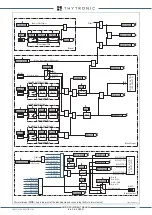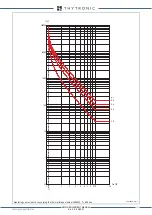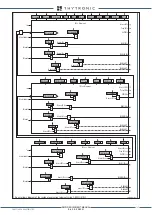
FUNCTION CHARACTERISTICS
175
—
Phase overcurrent - 50/51 Side H and Side L
Preface
Three operation thresholds, independently adjustable with adjustable delay are provided on both the
H and L side of the protected device.
References used in this section are related to the protection of the H side: the elements on the L side
is similar (replace the H with L).
The first one may be programmed with definite or inverse time according the IEC and ANSI/IEEE
standard, as well as with rectifier, I
2
t or EM curve.
The second threshold may be programmable with independent or dependent time according to the
I
2
t curve and the third threshold with independent time.
For each threshold a reset time can be set useful to reduce the clearing time for intermittent faults.
The first threshold trip may be inhibited by start of the second and/or third threshold.
Similarly the second threshold trip may be inhibited by start of the third threshold.
Operation and settings
Each phase fundamental frequency current is compared with the setting value. Currents above the
associated pickup value are detected and a start is issued. After expiry of the associated operate
time a trip command is issued; if instead the current drops below the threshold, the element is re-
stored.
The first threshold (
I
>) may be programmed with definite or inverse time according the following
characteristic curves:
• Standard Inverse Time (IEC 255-3/BS142 type A or SIT):
t
= 0.14 ·
t
(H)
>
inv
/ [(
I
/
I
(H)
>
inv
)
0.02
- 1]
• Very Inverse Time (IEC 255-3/BS142 type B or VIT):
t
= 13.5 ·
t
(H)
>
inv
/ [(
I
/
I
(H)
>
inv
) - 1]
• Very Inverse Time (IEC 255-3/BS142 type B or LIT):
t
= 120 ·
t
(H)
>
inv
/ [(
I
/
I
(H)
>
inv
) - 1]
• Extremely Inverse Time (IEC 255-3/BS142 type C or EIT):
t
= 80 ·
t
(H)
>
inv
/ [(
I
/
I
(H)
>
inv
)
2
- 1]
• Moderately Inverse (ANSI/IEEE type MI):
t
=
t
(H)
>
inv
· {0.01 / [(
I
/
(H)
>
inv
)
0.02
- 1] + 0.023}
• Very Inverse (ANSI/IEEE type VI):
t
=
t
(H)
>
inv
· {3.922 / [(
I
/
I
(H)
>
inv
)
2
- 1] + 0.098}
• Extremely Inverse (ANSI/IEEE type EI):
t
=
t
(H)
>
inv
· {5.64 / [(
I
/
I
(H)
>
inv
)
2
- 1] + 0.024}
• Rectifier (RI):
t
= 2351 ·
t
(H)
>
inv
/ [(
I
/
I
(H)
>
inv
)
5.6
- 1]
• I-squared-t (
I
2
t = K):
t
= 16 ·
t
(H)
>
inv
/ (
I
/
I
(H)
>
inv
)
2
• Electromechanical (EM):
t
=
t
(H)
>
inv
· {0.28 / [-0236 · (
I
/
I
>
inv
)
-1
+ 0.339]}
where:
t
:
operate time
I
(H)
>
inv
:
threshold setting
t
(H)
>
inv
:
operate time setting
The second threshold (
I
>>) may be programmable with definite or inverse time according to the I
2
t
curve:
t
= 16 ·
t
(H)
>
inv
/ (
I
/
I
>
inv
)
2
The third threshold is definite time.
For all inverse time characteristics, following data applies:
• Asymptotic reference value (minimum pickup value): 1.1
I
(H)
>
inv
• Minimum operate time: 0.1
s
• Range where the equation is valid:
[1]
1.1 ≤
I
/
I
(H)
>
invv
≤ 20
• If
I
>
inv
pickup ≥ 2.5
I
n
, the upper limit is 50
I
nH
For all definite time elements the upper limit for measuring is 50
I
nH
.
All overcurrent elements can be enabled or disabled by setting
ON
or
OFF
the
I(H)> Enable
,
I(H)>> Enable
and/or
II(H)>>> Enable
parameters inside the
Set \ Profile A (or B) \ Phase
overcurrent-50/51 side H \
I(H)> Element
(
I(H)>> Element
,
I(H)>>> Element) \ Setpoints
menus.
The first overcurrent element can be programmed with definite or inverse time characteristic by
setting the
I(H)>Curve
parameter (
DEFINITE, IEC/BS A, IEC/BS B, IEC/BS C, ANSI/IEE
MI, ANSI/IEE VI, ANSI/IEE EI, RECTIFIER, I2t, EM
) available inside the
Set \ Profile A (or B) \
Phase overcurrent-50/51 side H \
I(H)> Element
(
I(H)>> Element
,
I(H)>>> Element) \ Setpoints
menu.
Note 1 When the input value is more than 20 times the set point , the operate time is limited to the value corresponding to 20 times the set point
t-int-F50-51.ai
I
I
>>
I
>>>
t
>
t
>>
t
>>>
I
>
t
General operation time characteristic for the phase overcurrent elements - 50/51
TRIP
XMR-D EQUIPMENT MANUAL
Ed. 2.9 - 02/2021






























